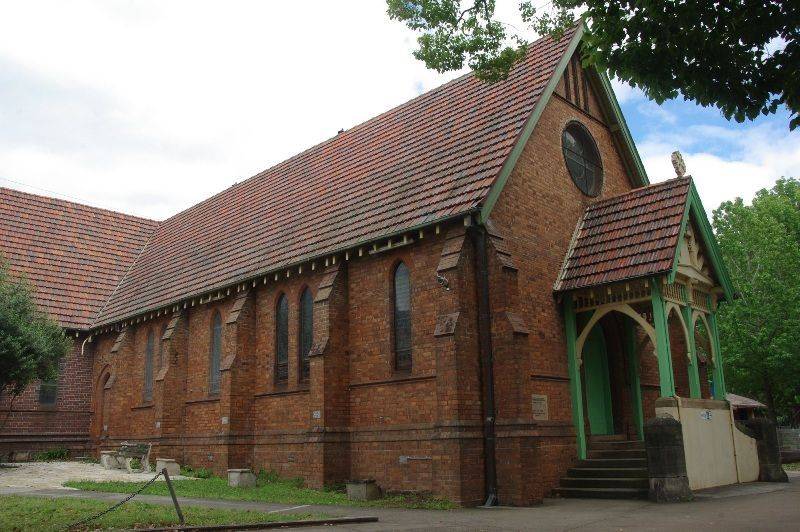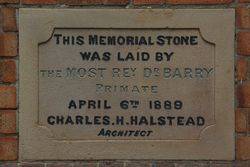
St George's Anglican Church Memorial Stone Print Page 
The stone was laid in 1889 to commemorate the building of the church. The church was opened in October 1889.
At Hurstville, on Saturday afternoon, the Bishop of Sydney laid the memorial stone of St. George's school-church, which is being erected on the site of the recently removed building, near Gannon's Forest-road, which had been used for a similar purpose for about 30 years. The interesting ceremony was witnessed by a fairly large number of local residents and a few visitors. The new building, which will be rather more than twice the size of the old one, will afford sitting accommodation for about 200 people. It will be completed in three months from the present time. The estimated cost is about £800, of which nearly £600 are already in hand.
The walls are to be "cavity" walls, 18in. thick, the outside bricks being dark red ones, made at Hurstville, the lining consisting of Cook's double-pressed white bricks, and the windows, buttresses and string courses being formed of red moulded bricks, supplied also by Mr. Cook, of Marrickville. There is to be an open timbered porch, and the roofing of the entire structure will be slate. The principal window will be given by Mr. Kinsela, of Bexley. It is intended at some future date to add a library and a classroom as wings near the western end of the building. The building committee are the Rev. W. H. Saunders, Messrs. G. Brown, D. James, J. M'Kern (churchwar-dens), C. H. Halstead, S. Hodges and J. H. Walker. They purchase all the materials required, but Mr. Henry Clapham, of Hurstville, is the contractor for the brick work, and Messrs. Campbell and Mackintosh, of Pyrmont, for the carpentering.
Bishop Barry delivered a brief address after laying the memorial stone. In the course of his remarks, he said that the more he had lived here and the more experience he had gained, the more he seemed to see in all directions that what we had to desire was a larger, broader and more united life — a life in which we would be content to sink our own personal impor-tance, our own personal fancies, even (if he might say so) our own personal religious luxuries— a life in which we would be ashamed to break up church unity by sects and parties, always dwelling on the things in which men differed, and not on the things in which they agreed, but where we would all work together freely and yet in the right order, as individual members of Christ and yet as one holy catholic church. God grant it to those in that parish, as in all others.
He rejoiced to be with them, though for the last time, that day, to lay that memorial stone, which indicated growth from the old humble church of some 30 years ago to one that was more suited to the present necessities of that growing neighborhood, and he earnestly trusted that the difference in the material fabrics might be a symbol of the difference in the spiritual church— that they might have continually, in the first place, a life in which every individual was vital in the Lord Jesus Christ, and yet a life in which they were all in one great brotherhood, working together for the faith once delivered to the saints. Might God's blessing rest upon them and upon that church. Let them do that which still remained to be done for its erection, and, when soon it was opened and consecrated, might God grant there the gift of His spiritual presence and make that material fabric the means of building up that glorious Church which had neither split nor wrinkle nor any such thing.
Daily Telegraph (Sydney), 8 April 1889.
Location
| Address: | The Avenue & Forest Road, St George`s Anglican Church , Hurstville , 2220 |
|---|---|
| State: | NSW |
| Area: | AUS |
| GPS Coordinates: | Lat: -33.966874 Long: 151.108161 Note: GPS Coordinates are approximate. |
Details
| Monument Type: | Plaque |
|---|---|
| Monument Theme: | Culture |
| Sub-Theme: | Religion |
Dedication
| Actual Monument Dedication Date: | Saturday 6th April, 1889 |
|---|
This Memorial Stone was laid by the Most Rev. Dr. Barry Primate
April 6th, 1889
Charles H. Halsted
Architect






